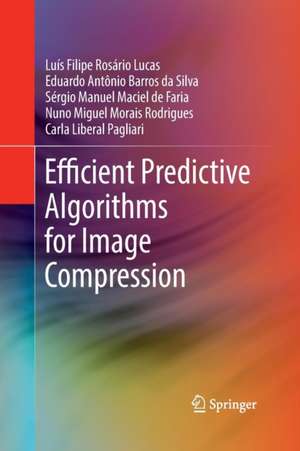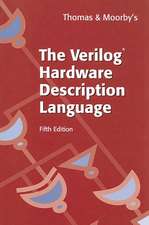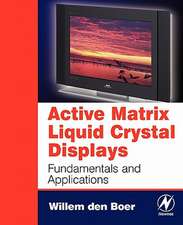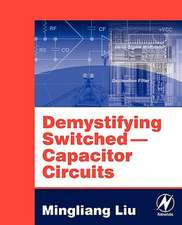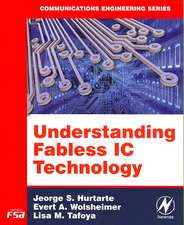Efficient Predictive Algorithms for Image Compression
Autor Luís Filipe Rosário Lucas, Eduardo Antônio Barros da Silva, Sérgio Manuel Maciel de Faria, Nuno Miguel Morais Rodrigues, Carla Liberal Pagliarien Limba Engleză Paperback – 13 iul 2018
| Toate formatele și edițiile | Preț | Express |
|---|---|---|
| Paperback (1) | 635.31 lei 43-57 zile | |
| Springer International Publishing – 13 iul 2018 | 635.31 lei 43-57 zile | |
| Hardback (1) | 641.53 lei 43-57 zile | |
| Springer International Publishing – 27 feb 2017 | 641.53 lei 43-57 zile |
Preț: 635.31 lei
Preț vechi: 747.43 lei
-15% Nou
Puncte Express: 953
Preț estimativ în valută:
121.56€ • 127.27$ • 100.59£
121.56€ • 127.27$ • 100.59£
Carte tipărită la comandă
Livrare economică 07-21 aprilie
Preluare comenzi: 021 569.72.76
Specificații
ISBN-13: 9783319845883
ISBN-10: 3319845888
Ilustrații: XIX, 169 p. 66 illus., 24 illus. in color.
Dimensiuni: 155 x 235 mm
Greutate: 0.28 kg
Ediția:Softcover reprint of the original 1st ed. 2017
Editura: Springer International Publishing
Colecția Springer
Locul publicării:Cham, Switzerland
ISBN-10: 3319845888
Ilustrații: XIX, 169 p. 66 illus., 24 illus. in color.
Dimensiuni: 155 x 235 mm
Greutate: 0.28 kg
Ediția:Softcover reprint of the original 1st ed. 2017
Editura: Springer International Publishing
Colecția Springer
Locul publicării:Cham, Switzerland
Cuprins
Introduction.- Prediction techniques for image and video coding.- Image and video coding standards.- Compression of depth maps using predictive coding.- Sparse representation methods for image prediction.- Generalised optimal sparse predictors.- Conclusions and other research directions.- Test signals.- References.
Notă biografică
Luís Filipe Rosário Lucas was born in Portugal in 1988. He received the Engineering and M.Sc. degrees in Electrical Engineering from Escola Superior de Tecnologia e Gestão of Instituto Politécnico de Leiria, Portugal, in 2009 and 2011, respectively, and the Ph.D. degree from the Universidade Federal do Rio de Janeiro, Brazil, in 2016, in collaboration with the Instituto de Telecomunicações, Portugal. Currently, he is a researcher at the Instituto de Telecomunicações, in Leiria, Portugal. His research interests include image and video compression, digital signal processing and embedded systems.
Eduardo Antônio Barros da Silva was born in Rio de Janeiro, Brazil, in 1963. He got his B.Sc in Engineering from Instituto Militar de Engenharia (IME) in 1984, his M.Sc in Electrical Engineer from COPPE/UFRJ in 1990 and his Ph.D. in Electronics Systems Engineering from Essex University, England in 1995. Since 1989 he works at the Electronics and Computer Science Departament from Escola Politécnica (former Escola de Engenharia), from Universidade Federal do Rio de Janeiro (UFRJ). He was coordinator of the specialization course in Telecommunication Systems from Escola Politécnica (TELECOM) from 2003 to 2008. He also works since 1996 at the Programa de Engenharia Elétrica from COPPE/UFRJ, where he was Head of Department in 2002. He gives consulting and training in Image and Video Compression for TV operators in Brazil. In 1994 he won the "British Telecom Postgraduate Publication Prize" for his IEEE article on Aliasing in Subband Coding. He has been appointed a Distinguished Lecturer of the IEEE CAS Society for 2003 and 2004. His research interesses are in the areas of Digital Signal and Image Processing, Signal Coding, Digital Television, Wavelet Transforms, Mathematical Morphology and Telecommunications Applications. He is a member of IEEE, of the Brazilian Telecommunication Society (SBrT) and the Brazilian Television Engineering Society (SET).
Sérgio Manuel Maciel de Faria was born in Portugal in 1965. He received the Engineering degree in Electrical Engineering from Universidade de Coimbra, Portugal, in 1988, the M.Sc. degree in Electrical Engineering from Universidade de Coimbra, Portugal, in 1992, and the Ph.D. degree in Electronics and Telecommunications from the University of Essex, England, in 1996. In 2014 received the title of “Agregado” by Instituto Superior Técnico, University of Lisbon. He is Professor with the Department of Electrical Engineering, in Escola Superior de Tecnologia e Gestão of Instituto Politécnico de Leiria, Portugal, since 1990. He is an Auditor with A3ES organization for Electrical and Electronic Engineering courses in Portugal. He is a Senior Researcher with Instituto de Telecomunicações. His research interests include 2D/3D image and video processing and coding, motion representation, and medical imaging. He is an Area Editor of Signal Processing: Image Communication. He has been a Scientific and Program Committee Member of many international conferences. He is a reviewer for several international scientific journals and conferences (IEEE, IET and EURASIP). He is a Senior Member of the IEEE.
Nuno Miguel Morais Rodrigues graduated in electrical engineering in 1997, received the M.Sc. degree from the Universidade de Coimbra, Coimbra, Portugal, in 2000, and the Ph.D. degree from the Universidade de Coimbra, in 2009, in collaboration with the Universidade Federal do Rio de Janeiro, Rio de Janeiro, Brazil.
Since 1997, he has been with the Department of Electrical Engineering, Escola Superior de Tecnologia e Gestão, Instituto Politécnico de Leiria, Leiria, Portugal. Since 1998, he has been with the Instituto de Telecomunicações, Portugal, where he is currently a Senior Researcher. He has coordinated and is currently involved as a researcher in various national and international funded projects. His current research interests include digital signal and image processing, namely, image and video compression, point cloud and light field image and video compression, medical image compression and many-core programming.
Carla Pagliari is Senior Researcher and Professor at the Departamento de Engenharia Elétrica (SE/3), of the Instituto Militar de Engenharia, in Rio de Janeiro, Brazil. She received the Ph.D. degree in electronic systems engineering from the University of Essex, Colchester, U.K., in 2000. She was with TV Globo, Rio de Janeiro, Brazil, from 1983 to 1985. From 1986 to 1992, she was a Researcher with the Brazilian Army Research and Development Institute, Rio de Janeiro, Brazil. Since 1993, she has been with the Department of Electrical Engineering, Military Institute of Engineering, Rio de Janeiro. She has experience in the areas of television engineering and image processing, acting on the following topics: image/video coding, stereo/multi-view video coding, stereo systems, image/video synthesis, video streaming, and digital TV. She participated in the definition of the Brazilian Digital Television System and is a member of the Educational Board of the Brazilian Society of Television Engineering. She has projects in image processing for defense applications, image/video fusion of the infrared and visible-light signals, video over IP for applications in public safety, and digital TV. She acts as an Associate Editor of the Multidimensional Systems and Signal Processing (Springer) journal.
Textul de pe ultima copertă
This book discusses efficient prediction techniques for the current state-of-the-art High Efficiency Video Coding (HEVC) standard, focusing on the compression of a wide range of video signals, such as 3D video, Light Fields and natural images. The authors begin with a review of the state-of-the-art predictive coding methods and compression technologies for both 2D and 3D multimedia contents, which provides a good starting point for new researchers in the field of image and video compression. New prediction techniques that go beyond the standardized compression technologies are then presented and discussed. In the context of 3D video, the authors describe a new predictive algorithm for the compression of depth maps, which combines intra-directional prediction, with flexible block partitioning and linear residue fitting. New approaches are described for the compression of Light Field and still images, which enforce sparsity constraints on linear models. The Locally Linear Embedding-basedprediction method is investigated for compression of Light Field images based on the HEVC technology. A new linear prediction method using sparse constraints is also described, enabling improved coding performance of the HEVC standard, particularly for images with complex textures based on repeated structures. Finally, the authors present a new, generalized intra-prediction framework for the HEVC standard, which unifies the directional prediction methods used in the current video compression standards, with linear prediction methods using sparse constraints. Experimental results for the compression of natural images are provided, demonstrating the advantage of the unified prediction framework over the traditional directional prediction modes used in HEVC standard.
- Presents a state-of-the-art review of existing prediction technologies for compression of both 2D and 3D multimedia content;
- Discusses the most recent advances beyond the current, standardized technologies for image and video compression, such as using the HEVC standard in the context of natural images, 3D and Light Field content;
- Includes new prediction methods based on alternative techniques and concepts, including flexible block partitioning, linear prediction, sparse representation.
Caracteristici
Presents a state-of-the-art review of existing prediction technologies for compression of both 2D and 3D multimedia content Discusses the most recent advances beyond the current, standardized technologies for image and video compression, such as using the HEVC standard in the context of natural images, 3D and Light Field content Includes new prediction methods based on alternative techniques and concepts, including flexible block partitioning, linear prediction, sparse representation Includes supplementary material: sn.pub/extras
